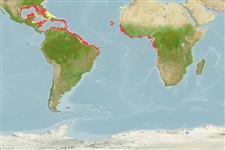Environment: milieu / climate zone / depth range / distribution range
Écologie
marin récifal; profondeur ? - 650 m (Ref. 3686), usually 50 - 300 m (Ref. 26999). Subtropical; 30°N - 14°S, 98°W - 15°E (Ref. 34024)
Western Atlantic: off the continental coast from Florida, USA and the Gulf of Mexico to northern South America, including islands in the Caribbean. Eastern Atlantic: off Senegal to Angola.
Taille / Poids / Âge
Maturity: Lm ? range ? - ? cm
Max length : 94.0 cm TL mâle / non sexé; (Ref. 40637); common length : 50.0 cm TL mâle / non sexé; (Ref. 5217); poids max. publié: 8.5 kg (Ref. 40637)
Description synthétique
Clés d'identification | Morphologie | Morphométrie
Épines dorsales (Total) : 0; Rayons mous dorsaux (Total) : 109 - 117; Épines anales: 0; Rayons mous anaux: 86 - 90. Body completely covered with small, imbricate, cycloid scales; barbels present on snout (6) and chin (6); branchiostegal rays 8; median basibranchial tooth patch absent; developed gill rakers on first arch 4 or fewer; pelvic fin rays inserted at about level of preopercle, well behind eye (Ref. 34024). Ventral fins dark, gradually becoming darker at the extreme blackish edge (Ref. 13608).
Common species (Ref. 34024). Adults benthopelagic (Ref. 34024) down to 650 m, but most often on the continental shelf (Ref. 3686), on sandy and muddy bottoms (Ref. 2683). Juveniles common in reefs (Ref. 34024). Smaller silvery specimens taken far out at sea in the epipelagic (Ref. 34024). Oviparous, with oval pelagic eggs floating in a gelatinous mass (Ref. 205).
Life cycle and mating behavior
Maturities | Reproduction | Spawnings | Egg(s) | Fecundities | Larves
Nielsen, J.G., D.M. Cohen, D.F. Markle and C.R. Robins, 1999. Ophidiiform fishes of the world (Order Ophidiiformes). An annotated and illustrated catalogue of pearlfishes, cusk-eels, brotulas and other ophidiiform fishes known to date. FAO Fish. Synop. 125(18):178p. Rome: FAO. (Ref. 34024)
Statut dans la liste rouge de l'IUCN (Ref. 130435)
Menace pour l'homme
Harmless
Utilisations par l'homme
Pêcheries: intérêt commercial mineur; pêche sportive: oui
Outils
Articles particuliers
Télécharger en XML
Sources Internet
Estimates based on models
Preferred temperature (Ref.
123201): 12.5 - 26.5, mean 19.7 °C (based on 331 cells).
Phylogenetic diversity index (Ref.
82804): PD
50 = 0.5156 [Uniqueness, from 0.5 = low to 2.0 = high].
Bayesian length-weight: a=0.00372 (0.00180 - 0.00768), b=3.15 (2.96 - 3.34), in cm total length, based on LWR estimates for this species & (Sub)family-body (Ref.
93245).
Niveau trophique (Ref.
69278): 3.9 ±0.6 se; based on size and trophs of closest relatives
Generation time: 5.9 ( na - na) years. Estimated as median ln(3)/K based on 1
growth studies.
Résilience (Ref.
120179): Milieu, temps minimum de doublement de population : 1,4 à 4,4 années (K=0.19).
Fishing Vulnerability (Ref.
59153): Moderate to high vulnerability (52 of 100).
Climate Vulnerability (Ref.
125649): High vulnerability (65 of 100).
Nutrients (Ref.
124155): Calcium = 16.9 [8.3, 42.6] mg/100g; Iron = 0.451 [0.245, 0.908] mg/100g; Protein = 17.8 [15.3, 20.4] %; Omega3 = 0.183 [0.095, 0.343] g/100g; Selenium = 36.5 [17.0, 76.8] μg/100g; VitaminA = 28.2 [8.7, 94.9] μg/100g; Zinc = 0.568 [0.373, 0.874] mg/100g (wet weight);
